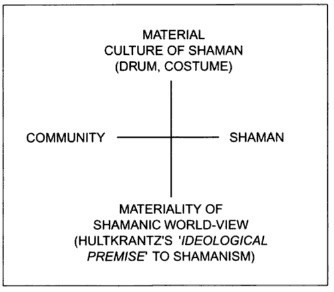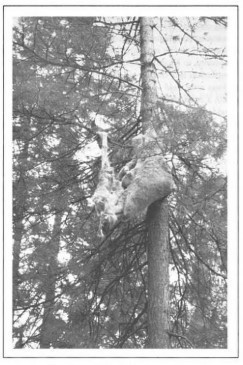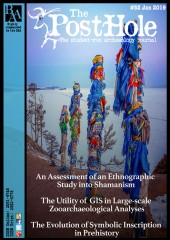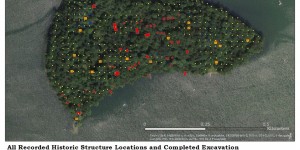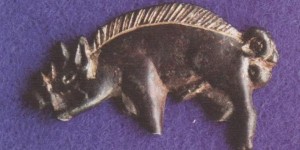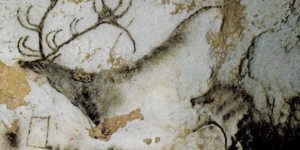Introduction
This paper will critically assess work by Peter Jordan on the material culture of shamanism. Chapter Six of The Archaeology of Shamanism (Jordan 2003) is entitled: The materiality of shamanism as a worldview: Praxis, artefacts and landscape. Jordan’s focus is on his long-term ethnographic study subjects, the Khanty people of Siberia. This paper will review, assess and evaluate his work, both in terms of its ethnographic and methodological foundations, and its implications for archaeological interpretation.
In general, Peter Jordan’s work is fascinating due to its deep and subtle engagement with Siberian foraging communities. What makes this work particularly interesting is the focus on how material culture can provide rich insights into shamanic belief systems. Trying to tease apart cosmology, belief, social structures and material culture is fraught with difficulty; Jordan aims to examine materials and landscapes within a framework of cosmology. This reveals patterns of deposition which otherwise appear inexplicable.
Shamanism & Belief
The chapter opens with an introduction to shamanism and the cosmology of the Khanty peoples. Shamans and shamanism have become contentious and diluted terms in the popular consciousness, often with little to no reference to their origins (Francfort, Hamayon & Bahn 2001). Often evoked as a primitive form of religion, Jordan understands shamanism to be a more fluid conception of belief. Following Hultkrantz (1973, 1978), he pivots the definition around a ‘complex’ of values which ultimately rest on the idea of a specialist who uses helper spirits to access supernatural realms by means of altered or ecstatic forms of consciousness. This loose description then allows the Khanty to belong to the group of Siberian peoples who make use of such a phenomenon without direct recourse to the word šaman, which they lack in their vocabulary. Jordan stresses the cosmological and everyday significance of such a belief structure and argues that it differs from a standard conception of religion (Pentikäinen 1996). One crucial difference is the layered way in which cosmology, material culture and landscape become indivisible. After this general outline, Jordan elucidates the Khanty understanding of shamanism, not least by sketching a cosmological and spiritual map (Figure 1).
The physical relationships between the landscape and beliefs of the Khanty are startlingly direct. Their inner representation of the cosmos as having three tiers is mapped out thus: the upper world is governed by a master force called Torum who is the source of goodness, the middle world is the realm of humans, animals, good and evil, and the lower world is black and home to sickness, ruled by Kyn Lung. Connecting these realms is the river Ob’ which runs through the human world from the upper to the lower world, with the warmer south being the home of Torum and the colder north the home of Kyn Lung. In this way the landscape is the cosmology; the Khanty dead live and dwell past the river to the frozen north. The Khanty understand that animate beings contain a form of soul called lil which can become loose, ill or lost through dreaming, theft and the thoughtless discarding of personal possessions. To possess some form of animation is to have lilenky, a term describing animals, plants, rocks, rivers and other objects. This ontological depiction of animation is crucial to understanding how the Khanty engage with their materials and environment. This opening ethnography of Khanty shamanism helps orient the reader to the landscape in which the group live - the river is a potent connection between sources of abundance and of sickness, between the living and the dead. By widening the scope of material culture to include landscape and cosmology, Jordan allows the all-encompassing nature of their beliefs to come to the fore, and this lends later interpretations a real explanatory power. The downside to this totality is that it offers limited scope for alternative explanations of material culture practices. Methodologically, this approach exists within the framework of ‘standpoint epistemology’ (SE) - the theory of knowledge that takes the intersubjective reality of individuals and groups as a valid source of truth (Stoetzler & Yuval-Davis 2002; S. Harding 2004; S. G. Harding 2004). The Khanty have particular beliefs as to the nature of their existence and the nature of the world they inhabit. SE allows Jordan to build a rich description of their beliefs and present them as a construction in which the Khanty find meaning and understand their reality. The key theory here is that reality is relative to the observer and that inter-subjectivity dismisses the need for an objective standard of reference (Bowell 2011; Hartsock 1998). More recently, this methodology has moved from feminist studies into the creation of ‘indigenous standpoints’, with researchers facilitating epistemic claims by marginalised societies (Foley 2006; Foley et al. 2003; Nakata et al. 2007; Moreton-Robinson 2013). The strength of ethnoarchaeology in this kind of research is that it provides the epistemological groundwork of human behaviour, which can result in otherwise puzzling or inexplicable depositions or assemblages. The disadvantages of using SE are plentiful, but within ethnoarchaeology it allows scholars to ascribe single static identities onto studied subjects without allowing for disagreements and tensions between individuals. An obvious place this could occur would be when assessing the strength of belief within the Khanty as to their shamanistic worldview. It may be necessary to be reminded that, even within animistic belief systems, there remains room for dissent, ridicule and ironic detachment (Willerslev 2013).
Khanty Society
Jordan moves from describing the shamanic worldview to more detailed descriptions of the Khanty themselves and the broader social roles of shamans. Individual shamans are permitted to have two main functions within Khanty society, to be the ‘reflector’ of the particular cultural constructions and customs of the Khanty and to be the sole agent of negotiation between the upper and lower worlds with regards to people’s health. However, it is also the case that shamans are often marginal figures, and a multitude of other interactions (such as animal taboos and the influence of deceased relatives) are of more importance to an individual’s wellbeing. The history of the Khanty is briefly illuminated through an examination of three key periods: the period of Russian expansion, taxation and economic regulation; the period of Soviet oppression of shamans and shamanism; and the period of mineral extractive industry. Each is reported to have caused profound changes in Khanty society which resonate up to the present, particularly in the manner of yurt living, which severed the living chain of shamanic tradition. Ethnography can only become more productive and focused when the historical contexts of particular people are taken into consideration, so this reflection on Khanty history adds weight to the conclusions that Jordan draws. His description of shamanism, however, could be teased out and more critically assessed.
The early definition of shamanism as a complex of values gives way to a definition of shamanism as ‘ideological’, largely influenced by Hultkrantz (1996). Describing shamanism as ideological seems to be in contradiction to the looser, fluid schema of shamanism as a complex of values. Hultkrantz himself was inclined to generalise Eurasian and Palaeo-American shamanism as sharing ideological foundations which have persisted since the Palaeolithic (Kehoe 1996). Jordan’s ethnoarchaeological research doesn’t seem to mesh easily with this idea of an unbroken historical chain of ideology reaching into prehistory, especially in light of his own historical contextualising for the Khanty. In their work on the history of state and shaman relationships, Thomas and Humphrey (1996; 1994) question how valid shamanism can really be given the influence of Chinese, Mongol, Islamic and Russian empires in Siberia. But if shamanism cannot be reduced to ideology, and if scholars cannot be certain as to the exact influence of outside forces on the Khanty, authority for the nature of Khanty shamanism rests solely with the people themselves. The crux of the matter is then laid bare - why does Jordan seek to use the ideological premise to ground the Khanty belief system? Why does the Khanty’s own description not suffice?
Khanty Material Culture & Landscape
The next section hones in on Khanty material culture and their relationship with the landscape. The Khanty are summarised as a semi-nomadic egalitarian group who aggregate in the summer and spend the winter hunting in the taiga forests. In order to secure success for the hunt each family must provide gifts or pory to the forest spirit Wuhnt Lung, who in turn ensures access to game animals. The raised islands in the boggy terrain are considered potent places to propound pory, which can include depositing bones or bottles, consuming elk heads or vodka, draping white sheets from trees or sometimes dispatching live reindeer as a sacrifice (Figure 2).
Other ritualised interactions with the landscape include the carving, curation and deposition of wooden anthropomorphic dolls, the building of wooden houses in sanctified stretches of woodland, and the visiting and placation of related souls in cemeteries. Together, these link into a network of sacred or spiritually important sites which are maintained in the face of human engagement with taiga resources, particularly the hunting of game animals. Alongside the landscape there are also highly formalised routines for the killing, butchery, consumption and disposal of animals and animal parts. Since each animal is watched over and owned by a particular spirit, the Khanty take great pains to observe correct ritual and not to damage the equilibrium between the animal and human world. To alter these relations would be to invite a number of undesirable consequences, including the failure of the hunt.
This type of ecological and animistic engagement between the human, spirit and animal worlds has been more closely studied in recent decades. Of particular interest has been the highlighting of animistic ontological claims or ‘flat ontologies’ (VanPool & Newsome 2012; Alberti et al. 2011; Halbmayer 2012; Bird‐David 1999; Costa & Fausto 2010; E. V. de Castro 1998; E. B. V. de Castro 2004). The academic focus on materials, objects, networks, affects and physical properties has been dubbed ‘the ontological turn’, but includes a variety of methodological approaches including Object-Oriented Ontology and Actor-Network Theory (Hemmings 2005; Morton 2011; Munro 2009; Callon & Blackwell 2007). Parsing aside, the more abstract use of flat or relational ontologies away from a study of animism proper reveals a rich and growing body of research into the nature of animistic beliefs. This has allowed Jordan to engage with the Khanty on their own terms concerning their beliefs and activities within the landscape. Terms like ‘equilibrium’, ‘mediation’, ‘ecological,’ and ‘relationships’ make sense within a general framework where personhood is a more distributed concept and agency built into the landscape itself. Jordan never uses the term animism in this work, but the form of shamanic worldview the Khanty inhabit is a synonym for animism, albeit with its own distinct acculturations. While Jordan is not seeking to analyse Khanty material culture through an academic notion of relational ontology, he nevertheless brings in both Ingold and Bourdieu to reinforce his conclusions. Ingold’s work on animism and Northern hunter-gatherers blends a more abstract materiality focused on objects with discrete animistic belief systems (Ingold 2011, 1986). While this is less important for Jordan’s methodology in analysing the Khanty, it is relevant in his conclusions. The lessons being drawn from the Khanty are that shamanistic material culture leaves behind unusual and obscure traces on the landscape which can only be explained by archaeologists sympathetic to the belief systems that may be responsible. It can be tempting to use animistic belief systems simply to explain the inexplicable (Mellars 2009). This is where the academic focus on ontology, effect and objects can be more useful, providing agency to artefacts without necessitating that the culture which manufactured them is shamanistic or animistic (Conneller 2004).
There is a methodological distinction between what could be called ‘academic animism’ and ‘cultural animism’. Allowing the Khanty to explain their culture by permitting cultural animism is a strength of Jordan’s chapter, but it sets up a potential equivocation between the academic and the cultural. Given that one of the aims of the work is to provide researchers with interpretative tools, there is a failure here to parse out terminology. Another potential oversight is the description of material practices as only belonging to a particular set of intentions on the part of the Khanty. Jordan focuses heavily on the health and hunting aspects of the depositions and taboos, but other researchers in Northern Eurasian ethnography have noted the animistic logic to leave visible traces of offerings and symbols can also be part of territorial marking and defense (Bicho, Detry & Price 2015; Sellers 2010). Platforms, animal bones, tree stumps, tree markings and burials can all be demarcations of territory both against the living and the dead (Grøn, Turov & Klokkernes 2008). There is also the undiscussed possibility that deposition and taboo might be driven by intentions outside of the shamanic framework - hygiene, competition, rivalry, personal arguments, romance, friendship and all the myriad reasons why humans behave in seemingly unfathomable ways. The Khanty are as capable of rational and irrational thought and behaviour as any other human society, therefore it is unlikely that all their activity can be subsumed by one generalised framework. Ultimately, Jordan is successful in his conclusions. The incorporation of some degree of sympathy on the part of archaeologists towards shamanic material culture can only help with future interpretations. He makes a solid case, building from abstract principles through to concrete deposition examples, and traces connections between them which seem legitimate and insightful. The concerns about using ethnography in archaeological interpretation will always remain, but in this instance looking to cultural beliefs as an explanation for more ephemeral or puzzling assemblages has already proved invaluable. One especially fruitful location has been the Mesolithic site of Star Carr, where the use of shamanic and animistic principles has helped build a case for such practices in prehistory through the material culture left behind, including pendants (Milner et al. 2016) and antler headdresses (Little et al. 2016). Across the Mesolithic literature, shamanic interpretations have been widely accepted for human burials (Porr & Alt 2006; Schmidt & Voss 2000), animal bone curation and burial (Mannermaa 2013; Overton & Hamilakis 2013) and human-animal interactions (Borić 2003). Jordan’s work in helping to develop a more nuanced and subtle approach to archaeological interpretation has certainly been welcomed and will be used for years to come.


